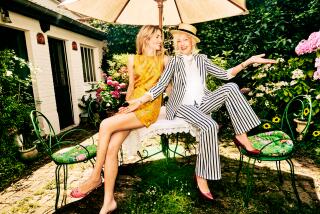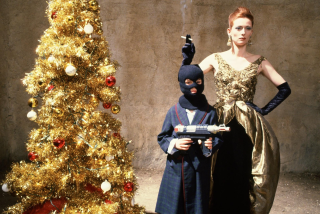Review: Agnès Varda and JR embark on a lovely, restorative road trip in ‘Faces Places’
“It’s good to see a woman standing tall.” The words are spoken by the Belgian-born filmmaker Agnès Varda late into her wonderful new movie, as she and her crew snap photographs of three women in the French port city of Le Havre. Her plan is to make the women stand as tall as possible by printing out their portraits in large-scale, black-and-white reproductions and then plastering them against a massive tower of shipping containers.
At age 89, Varda herself stands about 5 feet tall but casts an enormous shadow. A master of her art, a pioneer of the French New Wave and, recently, the curator of perhaps the world’s most delightful Instagram account, she seems, if anything, to gain in nimbleness and curiosity with age. Her eyesight may be fading — a condition she invites us to share, at two key moments, in blurry point-of-view shots — but her openness to the world, her very driving force as a filmmaker, seems undimmed by the passage of time.
The title of her latest — “Faces Places” in English, “Visages Villages” in French — is as charmingly compact as she is, and as playfully matter-of-fact. For 89 minutes, Varda — teaming up with 34-year-old photographer and artist JR — takes us on a brisk, invigorating tour of various towns dotting the French countryside, riding in a large truck equipped with a photo booth and painted to look like a giant camera. At each new destination, the two chat with the locals, take their portraits and then paste them on the sides of houses, barns, shops and other structures in the vicinity.
It’s a participatory art project with rich antecedents in both’s work, including “Mur Murs,” Varda’s 1981 documentary about murals in Los Angeles, and JR’s 2014 photo installation “Au Panthéon!” in Paris. And the effect is startling to behold, especially for the portraits’ subjects, who are often taken aback to see their faces enlarged and displayed over the places they call home.
A woman named Jeanine, upon seeing herself enshrined on the red-brick walls of the deteriorating mining town she has long called home, gasps and begins to cry. “I don’t know what to say,” she says. If there were even a hint of self-congratulation on the film’s part, it would immediately be chased away by Varda, who gives the woman a reassuring little hug: “Jeanine, it’s not sad. We’re friends now!”
You suspect that Varda, with her warm, friendly manner and her natural gift for listening and observing, makes friends fairly easily. In her 2000 documentary, “The Gleaners and I,” she established her ethos as a tireless, hawk-eyed collector of people and their stories, particularly those who society has seen fit to cast aside. As she and JR travel up and down the countryside, stopping off at sprawling farms and hillside cafés, they capture a fleet and funny travelogue that is also a moving record of a fast-changing way of life.
They speak with a farmer who marvels at the latest high-tech advances in bulldozing equipment but also notes, wistfully, that a once-thriving communal activity has now become a smaller solo operation. (His farm is in Chérence, Normandy, near the former home of Varda’s friend, the late writer Nathalie Sarraute.) Elsewhere, their work has an implicit dimension of advocacy, as when they visit a salt factory whose workers face long hours and chemical hazards. They erect a portrait of a goat on the side of a barn, its horns bared, in protest of the common local practice of dehorning.
The images they capture — strung together with playful visual transitions, snippets of voice-over and a jaunty score — provide both a unique snapshot of contemporary life and a poignant testament to life’s evanescence. And this, in turn, leads Varda to reflect quietly on the subject of her own impermanence, which haunts this picture in the gentlest of ways. “Faces Places” turns out to be a road movie in more than a merely literal sense. It is at once a roving journey into environments we rarely see in cinema and an incomplete but invaluable map of Varda’s memories.
Some of these memories are shared ones, particularly among cinephiles well versed in the movement that Varda helped bring into being. In one delightful scene, her companion pushes her in a wheelchair through a museum gallery, re-creating one of the most memorable moments in Jean-Luc Godard’s “Band of Outsiders.” JR, with whom Varda forms an affectionately bickering, perfectly mismatched duo, likes to hide behind a pair of hipster shades, making him a perfect contemporary stand-in for the Godard whom Varda captured in her 1962 classic, “Cléo From 5 to 7.”
The real, present-day Godard is never seen in “Faces Places,” though he is invoked at several instances, particularly in one emotionally startling scene that plays like a harsh, bittersweet reckoning for these two towering octogenarian artists. And Varda, with the combination of rigor, spontaneity and generosity that has become her artistic signature, gives herself over fully to the emotion of the moment, embracing the beauty of what she has seen and, in the same instance, all that there still is to see.
------------
‘Faces Places’
(In French with English subtitles)
Rating: PG, for brief nude images and thematic elements
Running time: 1 hour, 29 minutes
Playing: Laemmle’s Playhouse 7, Pasadena; Laemmle’s Royal Theatre, West Los Angeles; and Laemmle’s Town Center 5, Encino
Movie Trailers
More to Read
Only good movies
Get the Indie Focus newsletter, Mark Olsen's weekly guide to the world of cinema.
You may occasionally receive promotional content from the Los Angeles Times.











